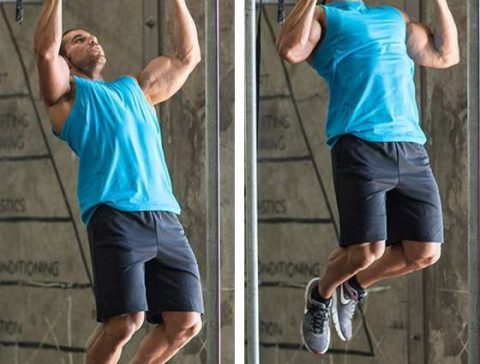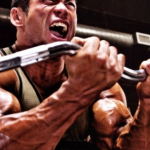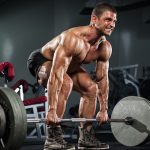What is the best and most common exercise for the development of almost all the muscles of the body? Pull-ups? No! Maybe squats? Also no! Chin-ups? Still no! There is no universal exercise that works out all muscle groups. But reverse grip pull-ups and chin-ups are the most effective upper-body exercises. A chin-up is a form of pull-up in which the range of motion is established in relation to a person’s chin.
Both reverse pull-ups and chin-ups are among the best exercises for back and overall upper body conditioning. However, they target the muscles a bit differently. Both exercises will work the latissimus and biceps, but standard chin-ups (with an underhand grip) place more emphasis on the biceps. Let’s consider chin-ups in more detail.
The basic exercise that promotes the development of biceps is pulling back grip. During this exercise, it is necessary to monitor the position of the body and arms to provide the necessary load on the muscles of the hands: errors in movement will lead to the fact that the main load will lie not on the biceps, but on the spinal muscles.
Reverse grip is convenient for both beginners and advanced athletes. In addition to the biceps, the latissimus dorsi, as well as the muscles of the forearm, which hold the body in weight, take part in the work. The muscles of the press play an important role: to reduce the participation of the spinal muscles, experts recommend twisting the body during pull-ups.
Types of pullbacks
As in the exercises on the direct grip, when pulling back the grip, you can use one of the options: medium or narrow.
- The average location of the palms when pulling back grip is considered classic. The palms are located shoulder-width apart with a grip on themselves, the thumbs form a “lock”. The upward movement should be started slowly and be careful not to lift the shoulders by inertia: they should be taken down and back, bringing the shoulder blades together. Proper exercise pumps the biceps and includes a group of spinal muscles.
- A reverse grip with a narrow arrangement of arms allows you to work out not only the biceps but also the lower part of the latissimus dorsi. Before performing the exercise, you should put your palms on the crossbar at the smallest distance from each other, turning them on yourself and closing the “lock” of the thumbs. Raising the body up, you need to bring the shoulder blades together, taking the shoulders back. At the highest point, the lower chest should touch the bar.
During the exercise, the shoulder joints have a rather large load, so it is necessary to move smoothly, without sudden movements and swaying. You should exhale when moving down, making sure that the elbows do not diverge to the sides and are parallel to each other.
Moving up, press the chin and twist the body slightly to highlight the biceps and reduce the load on the spinal muscles. The maximum bicep stress should be at the top of the amplitude. Pulling up, fix the position of the body, providing the biceps with a maximum static load. You need to go down slowly, without jerking – in time this phase should take about 3 seconds.
Why do you need reverse pull-ups
As for muscle gain, sticking to simple programs and techniques is the best approach.
You can make a large number of different movements, but for muscle growth and strength there is nothing better than basic exercises. Not to mention that if you are working with large weights, then the number of sets and reps per training should be limited. At the very least, you need to understand that no longer means better, but it can lead to problems associated with overtraining.
3-5 exercises per workout is a very good number for reference.
And, if you build a workout on basic exercises, this is more than enough to stimulate growth.
Regardless of whether you train one part of the body for a workout, perform a “pull-push” program or full-body workout for the whole body, pull-backs are something that cannot be neglected in those days when you train your back.
There are several reasons for this.
It goes without saying that pull-backs, as well as classical ones, are one of the best movements for training back muscles.
One study showed that they activate the same muscles with only slightly different intensities. The main difference is that with a direct position of the hands, the lower trapezius muscles are better activated, and with the opposite – the biceps of the shoulder.
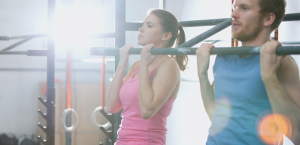
Are there any contraindications?
Before you read on, make sure that you are not someone who is contraindicated for reverse pull-ups/chin-ups.
- curvatures of the spine: kyphosis, scoliosis, lordosis;
- unevenly developed pectoral girdle;
- the trauma of the lumbar region;
- stretching of the muscles of the back;
- osteoporosis;
- osteochondrosis;
- postoperative trauma in the back;
- pregnancy;
- problems with the muscles of the press;
- prolapsed hernia;
- heart of vascular system problems
- postoperative trauma in the abdominal cavity.
If you have any of these indications, chin-ups can cause irreparable harm to the body and can even become the cause of disability!
What, why, and how?
Why do I need to do chin-ups? First, this is a basic exercise that involves a lot of joints and leads to an increase in testosterone. This exercise also:
- stretches the spine, eliminates pinching;
- develops core muscles of the spine;
- is an excellent prevention of curvature of the spine;
- can be performed without special equipment;
- does not require special training;
- works out the muscles of the biceps;
- develops a static grip;
- increases total muscle mass.
All these factors make chin-ups indispensable in:
- speed-strength sports;
- martial arts;
- yoga;
- Crossfit;
- bodybuilding;
- powerlifting.
Well, and, perhaps, it is worth noting the fact that among all the exercises that involve the top and bottom of the back, chin-ups with close grip without weight, are the only ones that are completely safe and work on the bicep. Since chin-ups work well on the biceps, then other muscles can be worked out separately. For example, after chin-ups it is good to do:
- vertical block row;
- front lat pulldown;
- shrugs with a bar behind your back;
- concentrated dumbbell lifts on the biceps;
- workout in the “rowing” machine;
- workout with a crossover of the biceps.
In this case, the benefits of chin-ups will be best. And do not forget about weight. After reaching a certain threshold (for example, 30 pulls in a set), you can hang weights on yourself.
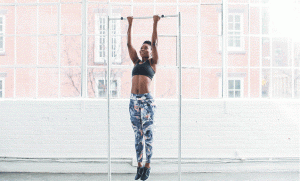
What muscles are working?
Chin-ups are a basic multi-joint exercise, due to which you build the dorsal core muscles.
| Muscle group | Load type |
| The latissimus | Active |
| The bicep flexors | Active |
| Abdominal muscles | passive |
| Lumbar muscles | Passive |
| Rhomboid muscles | Active |
| The bottom of the trapezius muscles | Active |
| Muscles of forearm | Passive |
Debunking myths – Close grip vs. Wide grip
- There is a myth that chin-ups with a wide grip are more beneficial to the body than chin-ups with a close grip. We will try to figure out if this is so. If we consider the mechanics of chin-ups, then when working biceps long head and short head with a wide grip, the amount of motion decreases, so the latissimus strains greater, but is not as deeply worked out. In addition, with a wide grip, rhomboid muscles are almost not involved. Instead, the bottom of the trapezius takes the load. However, the main difference is, with a fairly wide grip during chin-ups, the angle of the hands strains the elbow joint, which leads to its rapid wear. As for the close grip – then, when you work out:
the length of movement is extended, which provides deeper training of the muscles of the back;
- in the upper phase of the movement, the muscles that move the arm forward (inner bundles of the pectorals) are partially involved;
- there is no traumatic danger to the elbow joint;
- the load is evenly distributed between the rhomboid and the latissimus.
- the bicep flexor is involved as much as possible.
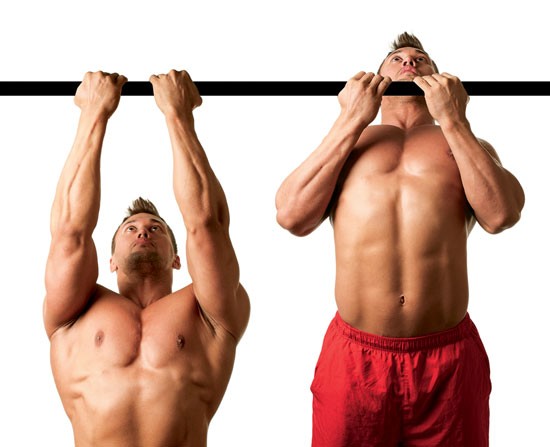
Chin-ups vs. Reverse Pull-ups
If we consider reverse pull-ups and chin-ups, then the situation is completely opposite. On the one hand – an overhand grip with the correct technique completely disengages the bicep flexor of the arm. This results in a big load on the back muscles – which makes them thicker and wider. The main load rests solely on the latissimus muscles. An underhand grip, however, involves additional muscle groups and increases the joint load. Thus, for overall progress, it is much more effective. As for the building of the muscles of the back – then due to the strain of the load by the biceps, the back is worked out less.
While both exercises take place in the vertical pulling movement plane, and they both primarily target the back (specifically the lats) and biceps, the way they do it is slightly different. Pull-ups typically use shoulder adduction, where the elbows come down and back from the sides. Chin-ups on the other hand use shoulder extension, where the elbows come down and back from the front (neutral grip fits in this category as well).
What’s the difference?
The difference isn’t huge and it doesn’t make one exercise better or worse than the other. It just means that both exercises train the lats in a slightly different way. Your goal is to build muscle/get stronger (and avoid overuse injuries). It would probably be a good idea to avoid always neglecting one type of movement in favor of the other.
So then, which will work better and faster for you? Well, putting the true best answer of “do what’s best for you” to the side for a second, experts say that the best (and safest) results come from using a mix of different grips.
Maybe do reverse pull-ups for lower reps one day, and then chin-ups for higher reps another day. Maybe do chin-ups for 8 weeks, then reverse pull-ups for the next 8 weeks. If your gym has neutral grip handles available, maybe give that a shot for the 8 weeks after that and then start the cycle over again with chin-ups.
Of course, if you find that a certain grip feels more or less ideal for you, you should make the obvious smart decision of using that grip more or less often. Whatever it ends up being, some type of vertical pulling movement (be it reverse pull-ups, chin-ups, or lat pull-downs) should almost always be a major part of your overall workout routine.
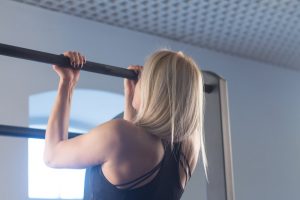
Technique
A chin-up is considered both the simplest and most difficult exercise in sport disciplines. It’s simple – the fact is that many athletes misuse the elbow.
- Hang on the bar.
- A grip should be shoulder-width apart;
- Hands are perpendicular to each other;
- The first chin-up is done in a smooth mode;
- You should pull by elbows and not by wrists;
- Pulling is carried out until the chest touches the crossbar;
- At the top, hold on 1-2 seconds;
- Then get down, but do not bend your elbows to the maximum.
In the presence of additional weight (in the form of irons), you should monitor breathing (inhalation in the lower phase, exhalation in the upper phase) and the position of the body. In particular, due to the displacement of the center of gravity, it is necessary to take into account the angle of ascent and to force the flection in the lower back. In the case of training without weight, the lower back takes the correct position on its own.
Mistakes
Despite the extremely simple technique, there are a number of mistakes that most athletes make. That’s why chin-ups lose most of their efficiency.
Mistake # 1 – pulling with wrists. In this case, the load falls entirely on the biceps, while the back is resting. Chin-up turns from a basic to an isolated exercise.
Mistake # 2 – bending feet or changing the position of the body. Many people, when they cannot pull themselves up, they begin to pull the body towards themselves. This changes the center of gravity and lets the muscles of the press move. You should never do that. Since the lumbar region is at this time in a stretched state, it is very easy to stretch or jam the ligament.
Mistake # 3 – you should never twitch on the bar. Reasons are described in mistake number 2.
Mistake # 4 – too wide grip. In this case, the elbow joint works in an unnatural way, which can result in dislocation and even a fracture.
Mistake # 5 – the full unbending of the elbows. This is the most common mistake for beginners. It seems to them that in this case, they get more load. However, this is not true. In this case, most of the forces go not to contracting the muscles of the back, but to overcoming the“30-degree” ligament barrier.
The main mistake: the performance of chin-ups too quickly. It is believed that in this case, more muscles are loaded. This is so, and there is the ability to build faster, get more pumping and, most importantly, use fast fibers. But at the same time, there is a serious risk of spinal injury, because of its stretched state. Because of this, it is easy to get a pinch of the spinal disc.
Key points on good technique
- Perform smooth reps. No cheating. Did you get stronger or just better at swinging yourself up and looking like a stud in the process? Bonus: Add weight to your cheating chin-ups to fast track your way to needing shoulder surgery.
- The arms should be straight at the start of each rep but not a dead hang. Keep your shoulders in their sockets. In order to understand, do this: put your arms straight above your head; shrug up as high as you can; now shrug down. We don’t want our shoulders loose in that shrugged up position. It’s the ‘down’ position with the shoulders ‘packed’ that we want to keep throughout the set. When people say “dead hang”, what they actually mean is arms straight.
- Use a shoulder-width grip or slightly narrower.
- The finish position is where your chin goes over the bar, elbows brought down to touch your side but not past it. Your chest may touch the bar depending on limb proportions, but that is not a defining factor of a full rep.
- Keep your glutes and abs tight. Tuck your neck, and do not cheat by craning your neck upwards as the reps get harder. You’re probably going to do it without realizing it, but try not to.
- No half reps. When you can no longer get a full rep, the set is over.
Other types of Chin-Up
Gorilla Chin/Crunch
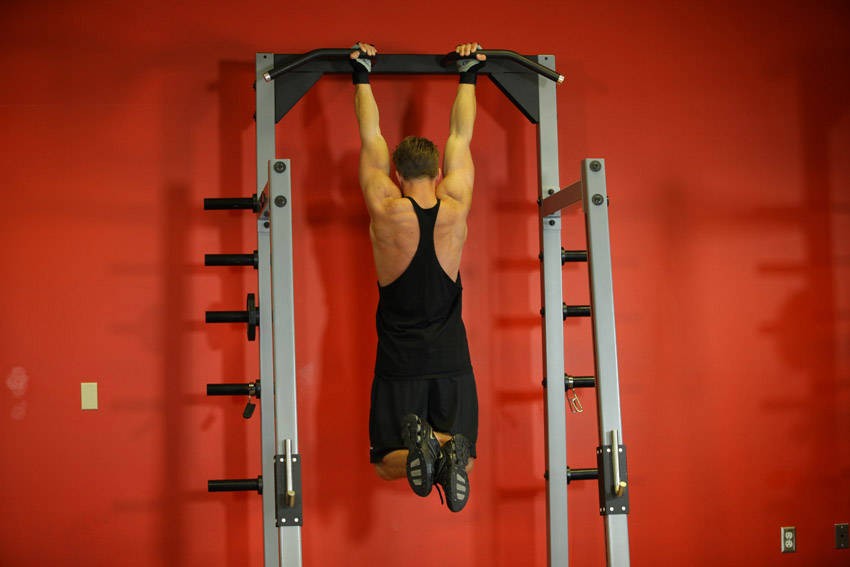
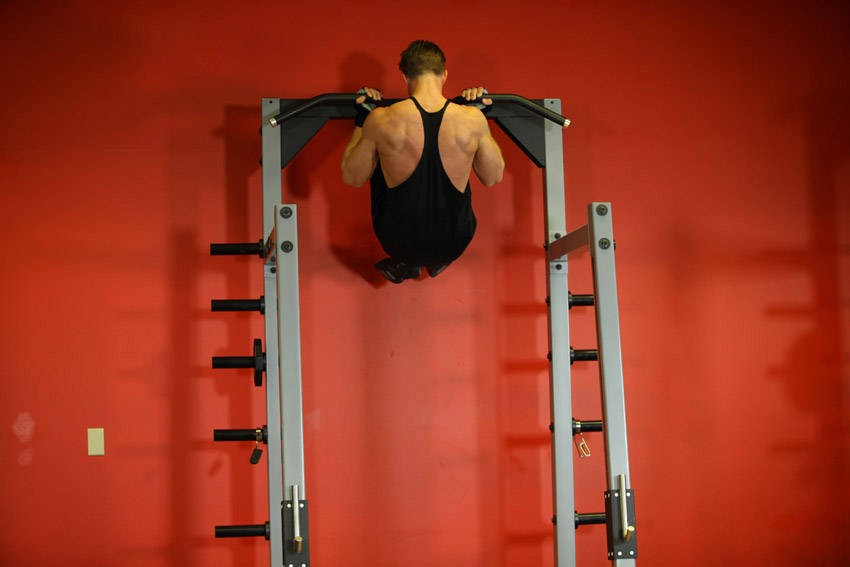
- Hang from a chin-up bar using an underhand grip (palms facing you) that is slightly wider than shoulder-width.
- Now bend your knees at a 90-degree angle so that the calves are parallel to the floor while the thighs remain perpendicular to it. This will be your starting position.
- As you exhale, pull yourself up while crunching your knees up at the same time until your knees are at chest level. You will stop going up as soon as your nose is at the same level as the bar.
Tip: When you get to this point you should also be finishing the crunch at the same time.
- Slowly start to inhale as you return to the starting position.
- Repeat for the recommended amount of repetitions.
Variations: You can also add resistance by holding a dumbbell or medicine ball between your feet but only the most advanced athletes should do this. Alternatively, when you are very advanced you can also try the one-arm version where you grasp your wrist with your free hand and you work the obliques more.
Weighted chin-ups
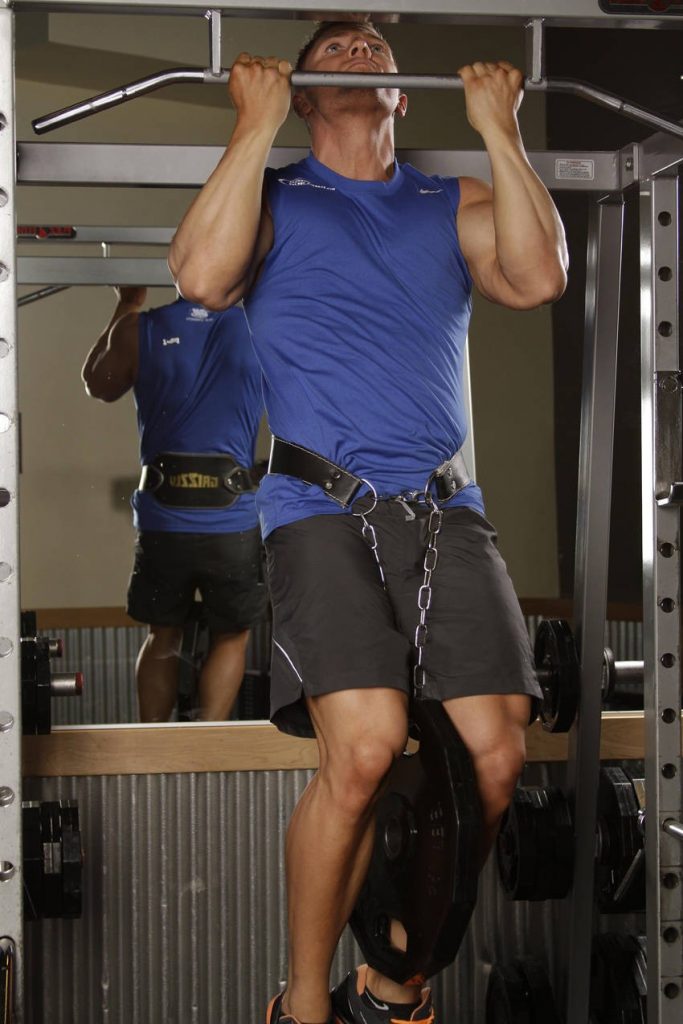
- Attach a weight to a chin belt and secure it around your waist. You can also hold a dumbbell between your feet. Grab the pull-up bar with the palms of your hands facing your torso and a grip closer than shoulder width. Your chest should be up and your back arched. This is your starting position.
- Now exhale and pull your torso upward until your head passes over the height of the bar. Ensure that during the movement you squeeze your shoulder blades back and down. Concentrate on squeezing the back muscles once you reach the full contracted position and keep the elbows close to your body. The upper torso should remain still as it moves through space and only the arms should move.
- Pause at the top as you inhale, and then slowly lower your torso back to the starting position where your arms are fully extended and the lats are fully stretched.
The result
Regardless of whether you decide to do reverse pull-ups or chin-ups, keep the right technique, or alternate both exercises. Only in this case, the load on the back muscles will be evenly distributed. In case you notice that one of the sides of the back does not build as fast as the second one, compensate for the load by pulling up on one arm, or perform one-side pulls to the dumbbell belt.
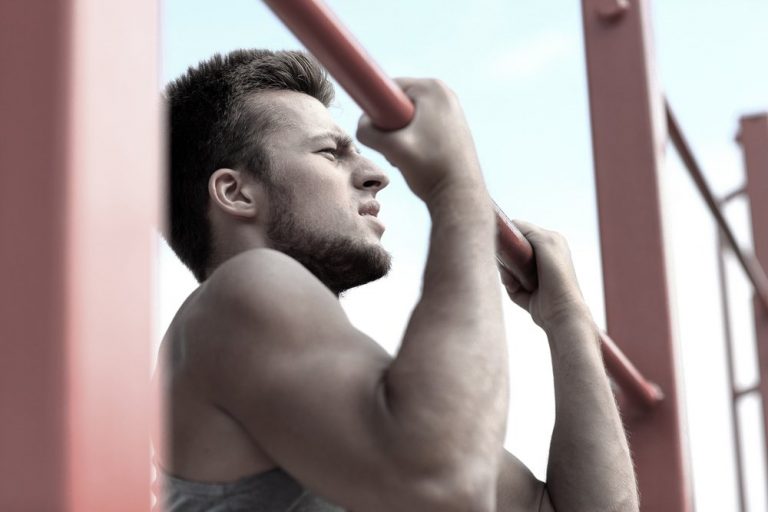
See also: The Turkish Lift Works All Muscle Groups

